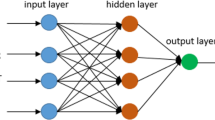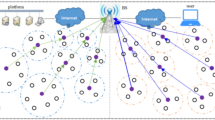Abstract
Unbalanced energy consumption of sensor nodes in wireless sensor network (WSN) leads to the formation of hotspots that can shorten network lifetime. Based on the study of hybrid energy-efficient distributed (HEED) clustering, a cell-clustered algorithm for energy efficiency (CC-HEED) is proposed to save the limited network energy in WSN. According to the power consumption model, the inner cluster regions in this hierarchy network are further divided into several cell-shaped areas, in which cell nodes are brought out to assemble the data in each cell area. In addition, comparisons are performed on network lifetime with other traditional routing algorithms to verify the validity of the routing protocol. Simulation results show that the proposed CC-HEED can significantly reduce energy consumption in WSN, and network lifetime is prolonged notably with high energy efficiency.











Similar content being viewed by others
References
André, R., Alok, S., & Marc, S. (2013). Lifetime maximization in wireless directional sensor network. European Journal of Operational Research, 231, 229–241.
Li, B. Y., & Chuang, P. J. (2013). Geographic energy-aware non-interfering multipath routing for multimedia transmission in wireless sensor networks. Information Sciences, 249, 24–37.
Yu, J. G., Deng, X., & Yu, D. X. (2013). CWSC: Connected k-coverage working sets construction algorithm in wireless sensor networks. International Journal of Electronics and Communication, 67, 937–946.
Zhang, P. F., Xiao, G. X., & Tan, H. P. (2013). Clustering algorithms for maximizing the lifetime of wireless sensor networks with energy-harvesting sensors. Computer Networks, 57, 2689–2704.
Senouci, M. R., Mellouk, A., & Senouci, H. (2012). Performance evaluation of network lifetime distribution for WSN routing. Journal of Network and Computer Applications, 35(4), 1317–1328.
Wang, H., Ren, W., & Cui, Y. (2012). An adaptive WSN node tracking algorithm based on rough-set neural network. Procedia Engineering, 29, 1750–1754.
Wang, Z., Wang, Y. L., & Ma, M. D. (2013). Efficient localization for mobile sensor networks based on constraint rules optimized Monte Carlo method. Computer Networks, 57, 2788–2801.
Stojmenovic, I., & Lin, X. (2001). Power-aware localized routing in wireless networks. IEEE Transactions on Parallel and Distributed Systems, 12, 1122–1133.
Acknowledgments
The authors would like to thank the Natural Science Foundation of Jiangsu Province (BK20130977), the Natural science foundation for colleges and universities in Jiangsu Province (13KJB580007) and Graduate Innovation Funding Project of Jiangsu Province (KYLX_0867) for partly funding this project.
Author information
Authors and Affiliations
Corresponding author
Rights and permissions
About this article
Cite this article
Xiao, G., Sun, N., Lv, L. et al. An HEED-Based Study of Cell-Clustered Algorithm in Wireless Sensor Network for Energy Efficiency. Wireless Pers Commun 81, 373–386 (2015). https://doi.org/10.1007/s11277-014-2134-z
Published:
Issue Date:
DOI: https://doi.org/10.1007/s11277-014-2134-z




